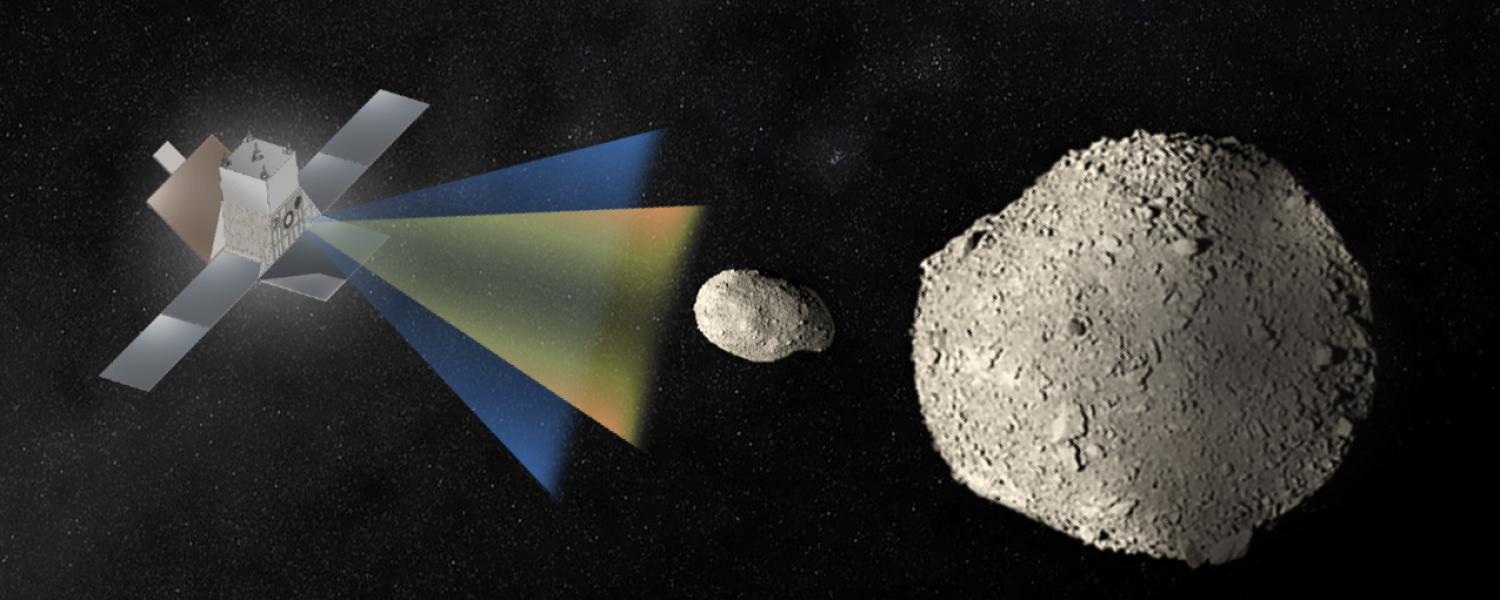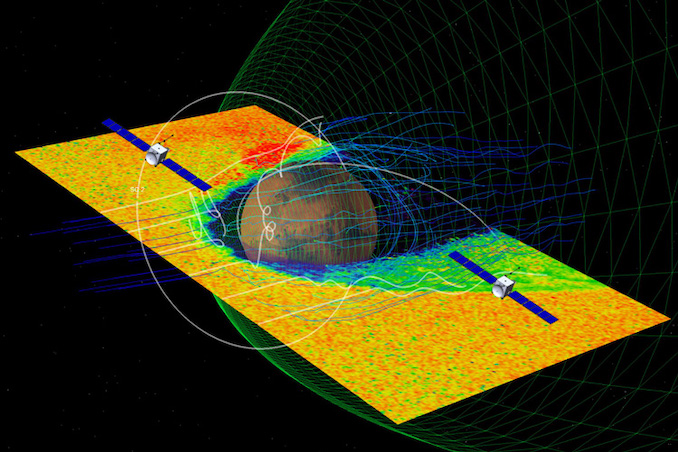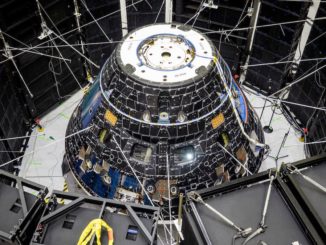
The first set of proposals for a new class of small robotic probes NASA wants to dispatch across the solar system came in with higher cost estimates than agency officials expected, a NASA manager said Sunday.
NASA selected three finalist mission concepts in June that could take off in the early 2020s to fly to the moon, Mars, or a near-Earth asteroid. Unlike NASA’s past planetary science missions, the missions selected in June will fly as secondary payloads on rideshare launch opportunities.
The mission proposals had to fit under a $55 million cost cap — excluding launch costs — and the prospective mission concepts submitted to NASA by scientists came in with higher budgets than expected, according to Carolyn Mercer, NASA’s program executive for the Small Innovative Missions for Planetary Exploration, or SIMPLEx, program.
“We put a cost cap of $55 million,” Mercer said Sunday in a presentation at the Small Satellite Conference, an annual industry meeting held at Utah State University. “In fact, we phrased it as we wanted to see proposals come in from $15 (million to $55 million. We were expecting to make selections across that range of costs. We were trying to encourage people to come in lower. The short answer is they didn’t.”
NASA officials expect to pick at least one of the three SIMPLEx finalists, which also come with a weight limit of about 400 pounds (180 kilograms), to proceed into development and launch.
In 2015, NASA selected the first two SIMPLEx missions. The two CubeSat missions, named LunaH-Map and Q-PACE, will measure hydrogen concentrations on the lunar surface and investigate the properties of low-velocity particle collisions in microgravity, an important part of planetary formation.
The new SIMPLEx competition is focused on larger spacecraft than the LunarH-Map and Q-PACE CubeSats. NASA first canvassed the planetary science community for input and preliminary mission concepts to see if smallsats could be useful for solar system exploration.
“Our conclusion was yes, in fact, excellent planetary science can credibly be done using small spacecraft,” Mercer said.
NASA identified several critical new technologies to make the smallsat initiative worth the effort for planetary science, including significant propulsion capabilities, high data rate communications, low volume power systems, radiation-tolerant flight computers, and aerocapture.
“We also found out, as far as the cost of these things go … small spacecraft can still carry large price tags,” Mercer said.
The three finalists selected by NASA from 12 proposals in June included Janus, which would send two microsatellites to fly by two binary asteroid systems, which consist of two objects orbiting one another. The Janus team is led by Daniel Scheeres of the University of Colorado, and Lockheed Martin would build and operate the two Janus spacecraft as they head for their asteroid targets.
The Janus spacecraft would carry visible and infrared imagers to survey the binary asteroid systems.
“We are going to send two suitcase-sized spacecraft to flyby two binary asteroid systems to study a binary asteroid system up close for the very first time,” Scheeres said. “What’s a binary asteroid? It’s a small body that at some point has been spun up so fast that it has ripped itself apart and come back together again as a mini-version of the Earth-moon system. So you have two bodies orbiting around each other.
“They’re so small that you could actually jump from one body to the other body in space,” Scheeres said. “No one’s studied them up close before, so Janus will be the first to do this, and it’s going to give us insight into the formation of the solar system, how the solar system has evolved up to the current day, and is still evolving.”
The Escape and Plasma Acceleration and Dynamics Explorers, EscaPADE mission, would send two smallsats to Mars to study how the solar wind is driving molecules out of the Martian atmosphere and into space.

Building on NASA’s MAVEN mission, which has orbited Mars since 2014, the EscaPADE smallsats would carry science instruments to measure magnetic fields, plasma, ion densities and electron flows around Mars. Unlike MAVEN, which is a single satellite, the EscaPADE mission would simultaneously measure the environment around Mars from two different locations.
The principal investigator for EscaPADE is Robert Lillis from the University of California, Berkeley.
The space around Mars is a windy place,” Lillis said. “Ionized gas flows constantly from the sun, blowing a gale of it at a million miles per hour. This flow, known as the solar wind, impacts Mars’s upper atmosphere directly, causing aurora and stripping Mars’s atmosphere away. Just like winds here on Earth, the solar wind is often gusty, causing Mars’s near-space environment to change rapidly on timescales of minutes or less.”
Each EscaPADE spacecraft would weigh less than 200 pounds (90 kilograms). Once at Mars, the two smallsats will change their orbits over time, taking data from altitudes between 120 miles (200 kilometers) and 4,350 miles (7,000 kilometers) above the planet.
The information collected by EscaPADE could help scientists determine how Mars dried out and got colder billions of years ago, causing the disappearance liquid water from the planet’s surface. When Mars was warmer, wetter and habitable, the planet had a much thicker atmosphere. Scientists want to know why Red Planet lost its atmosphere, a process the MAVEN mission revealed was largely driven by solar wind and radiation.
“Understanding this dynamic behavior requires more than one vantage point,” Lillis continued. “EscaPADE is a two spacecraft mission to trace the flow of matter and energy from the solar wind and into and out of Mars’s upper atmosphere. From complementary orbits, our twin spacecraft will help us untangle the cause and effect of the solar wind’s influence on Mars.”
The Janus and EscaPADE teams proposed launching their missions on the same rocket as Psyche, a Discovery-class science probe set for launch in 2022 to explore a metallic asteroid bearing the same name.
The third SIMPLEx finalist, Lunar Trailblazer, would launch as a secondary payload on a rocket carrying a primary satellite into geostationary transfer orbit.
Lunar Trailblazer could launch in two-to-four years, and the mission team is led by Bethany Ehlmann, a scientist at Caltech.
“We’re excited to be a part of NASA’s latest SIMPLEx selection and look forward to following up on one of the most exciting discoveries of the late 2000s, which is water on airless bodies, and in particular the moon,” Ehlmann said.
Lunar Trailblazer, measuring 16 feet (5 meters) long with its solar panels deployed, would orbit the moon at an altitude of about 60 miles (100 kilometers).
“Lunar Trailblazer is a small satellite, led by Caltech, built by Ball Aerospace, managed by JPL, with a JPL imaging spectrometer and thermal camera from the University of Oxford,” she said. “Our goal is to map water on the moon.
“We will look at the form of water on the sunlit side of the moon. Is it H2O? Is it OH, hydrogen stuck on to the oxygen in silicates?” Ehlmann said. “So we’ll figure out the form of water on the moon, and we’ll also peer into the permanently shadowed craters on the moon to map where water ice is, determine how much is there, and then determine whether it could be a resource for future human explorers.”
The Janus, EscaPADE and Lunar Trailblazer missions will continue development for up to a year until their preliminary design reviews, after which NASA will select one or more of the projects to fly in space.
The $55 million cost cap for then SIMPLEx program is about a tenth that of the Discovery program, a series of solar system exploration probes — including the InSight, Dawn and Mars Pathfinder missions — that was previously NASA’s most cost-constrained line of planetary science projects.
NASA also has more expensive planetary science missions in the New Frontiers program, which comes with a $850 million cost cap, and multibillion-dollar flagship missions, such as the Mars 2020 rover and Europa Clipper probe.
NASA wants to tap into the growing capabilities provided by small satellites to expand the space agency’s planetary science portfolio.
The Mars Cube One, or MarCO, mission sent the first CubeSats to another planet last year. Developed at NASA’s Jet Propulsion Laboratory, the MarCO CubeSats launched with the InSight Mars lander in May 2018 and flew by the Red Planet last November, relaying data from InSight back to Earth as the lander descend into the Martian atmosphere.
Each MarCO CubeSat was about the size of a briefcase, and the mission proved small satellites could function in deep space.
NASA wants to make rideshare launch opportunities available on all its future science missions to ensure the agency does not waste excess rocket capacity. Launchers often fly with with leftover mass and volume margins.
Mercer said NASA plans another round of SIMPLEx mission selections in 2020 for future launch opportunities.
“The idea would be we would select a primary mission, such as Dragonfly (a rotorcraft to fly over Saturn’s moon Titan), determine whether or not there’s excess launch vehicle capacity expected for that, and then right away go out and solicit for the secondary (payload), get the secondary started, so that we can get them to a PDR (preliminary design review), determine which one we are going to downselect for, and then procure the launch vehicle knowing both the primary and the secondary.”
Email the author.
Follow Stephen Clark on Twitter: @StephenClark1.



